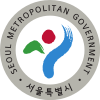
A | B | C | D | E | F | G | H | CH | I | J | K | L | M | N | O | P | Q | R | S | T | U | V | W | X | Y | Z | 0 | 1 | 2 | 3 | 4 | 5 | 6 | 7 | 8 | 9
Seoul
서울 Hanseong, Gyeongseong, Keijō | |
|---|---|
| Seoul Special City 서울특별시 | |
| transcription(s) | |
| • Hangul | 서울특별시 |
| • Hanja[a] | 서울特別市 |
| • Revised Romanisation | Seoul-Teukbyeolsi |
| • McCune–Reischauer | Sŏul-T'ŭkpyŏlsi |
| Motto(s): "Seoul, my soul"[1] | |
| Anthem: none[2] | |
| Coordinates: 37°33′36″N 126°59′24″E / 37.56000°N 126.99000°E | |
| Country | Republic of Korea |
| Area | Seoul Capital |
| Founded by | Taejo of Joseon |
| Districts | 25 districts |
| Government | |
| • Type | Mayor–council |
| • Body | Seoul Metropolitan Government Seoul Metropolitan Council |
| • Mayor | Oh Se-hoon (People Power) |
| • National Assembly | 49 |
| Area | |
| • Special city | 605.21 km2 (233.67 sq mi) |
| • Metro | 12,685 km2 (4,898 sq mi) |
| Elevation | 38 m (125 ft) |
| Highest elevation | 836.5 m (2,744.4 ft) |
| Lowest elevation | 0 m (0 ft) |
| Population (2Q 2023)[5] | |
| • Special city | 9,659,322 |
| • Rank | 1st |
| • Density | 16,000/km2 (41,000/sq mi) |
| • Metro | 26,037,000[4] |
| • Metro density | 2,053/km2 (5,320/sq mi) |
| • Demonym | Seoulite |
| • Dialect | Gyeonggi |
| GDP | |
| • Seoul Special City | US$388.8 billion (2022) |
| • Seoul Capital Area | US$909.6 billion (2022) |
| Time zone | UTC+9 (Korean Standard Time) |
| ISO 3166 code | KR-11 |
| Bird | Korean magpie |
| Color | Seoul Red[7] |
| Flower | Forsythia |
| Font | Seoul fonts (Seoul Hangang and Seoul Namsan)[8] |
| Mascot | Haechi |
| Tree | Ginkgo |
| Website | seoul.go.kr |
| Seoul | |
| Hangul | |
|---|---|
| Revised Romanization | Seoul |
| McCune–Reischauer | Sŏul |
| Seoul Special City | |
| Hangul | 서울특별시 |
| Hanja | |
| Revised Romanization | Seoul Teukbyeolsi |
| McCune–Reischauer | Sŏul T'ŭkpyŏlsi |
Seoul,[b] officially Seoul Special City, and formerly known as Hanseong and Keijō, is the capital of the Republic of Korea (ROK), commonly known as South Korea, and the country's most extensive urban center. The broader Seoul Capital Area, encompassing Gyeonggi province and Incheon metropolitan city, emerged as the world's fourth largest metropolitan economy in 2014, trailing only Tokyo, New York City, and Los Angeles, hosting more than half of South Korea's population. Although Seoul's population peaked at slightly over 10 million, it has gradually decreased since 2014, standing at approximately 9.97 million residents as of 2020. Seoul is the seat of the South Korean government.
Seoul's history traces back to 18 BC when it was founded by the people of Baekje, one of the Three Kingdoms of Korea. During the Joseon dynasty, Seoul was officially designated as the capital, surrounded by the Fortress Wall of Seoul. In the early 20th century, Seoul was occupied by the Japanese Empire, temporarily renamed "Gyeongseong." The Korean War brought fierce battles, with Seoul changing hands four times and leaving the city mostly in ruins. Nevertheless, the city has since undergone significant reconstruction and rapid urbanization.
Seoul was rated Asia's most livable city, with the second-highest quality of life globally according to Arcadis in 2015 and a GDP per capita (PPP) of approximately $40,000. 15 Fortune Global 500 companies, including industry giants such as Samsung,[9] LG, and Hyundai, are headquartered in the Seoul Capital Area, which has major technology hubs, such as Gangnam and Digital Media City.[10] Seoul is ranked seventh in the Global Power City Index and the Global Financial Centres Index, and is one of the five leading hosts of global conferences.[11] The city has also hosted major events such as the 1986 Asian Games, the 1988 Summer Olympics, and the 2010 G20 Seoul summit.
Seoul is geographically set in a mountainous and hilly terrain, with Bukhan Mountain positioned on its northern edge. Within the Seoul Capital Area lie five UNESCO World Heritage Sites: Changdeok Palace, Hwaseong Fortress, Jongmyo Shrine, Namhansanseong, and the Royal Tombs of the Joseon dynasty.[12] Furthermore, Seoul has witnessed a surge in modern architectural development, with iconic landmarks including the N Seoul Tower, the 63 Building, the Lotte World Tower, the Dongdaemun Design Plaza, Lotte World, the Trade Tower, COEX, IFC Seoul, and Parc1. Seoul was named the World Design Capital in 2010 and has served as the national hub for the music, entertainment, and cultural industries that have propelled K-pop and the Korean Wave to international prominence.
Toponomy
The city has been known in the past by the names Wiryeseong (위례성; 慰禮城, during the Baekje era), Bukhansangun (북한산군; 北漢山郡 during the Goguryeo era), Namcheon (남천; 南川,[13] during the Silla era), Hanyang (한양; 漢陽, during the Northern and Southern States period), Namgyeong(남경; 南京, during Goryeo era), Hanseong (한성; 漢城, during the Joseon era), and Keijō (京城) or Gyeongseong (경성; 京城) during Japanese rule.[14]
During Japan's annexation of Korea, Hanseong (漢城) was renamed Keijō (京城) by the Imperial authorities to prevent confusion with the Hanja '漢' (a transliteration of an ancient Korean word Han (한) meaning "great"), which also refers to Han people or the Han dynasty in Chinese and in Japanese is a term for "China".[15]
After World War II and the liberation of Korea, the city took its present name, which originated from the Korean word meaning "capital city", which is believed to have descended from an ancient word, Seorabeol (서라벌; 徐羅伐), which originally referred to Gyeongju, the capital of Silla.[16] Ancient Gyeongju was also known in documents by the Chinese-style name Geumseong (金城, literally "Gold Castle or City" or "Metal Castle or City"), but it is unclear whether the native Korean-style name Seorabeol had the same meaning as Geumseong.[citation needed]
Unlike most place names in Korea, "Seoul" has no corresponding Hanja (Chinese characters used in the Korean language). On 18 January 2005, the Seoul government changed its official name in Chinese characters from the historic Hancheng (simplified Chinese: 汉城; traditional Chinese: 漢城; pinyin: Hànchéng) to Shou'er (首尔; 首爾; Shǒu'ěr).[17][18]
History
Early history
Settlement of the Han River area, where present-day Seoul is located, began around 4000 BC.[19]
Seoul is first recorded as Wiryeseong, the capital of Baekje (founded in 18 BC) in the northeastern area of modern Seoul.[19] There are several city walls remaining in the area that date from this time. Pungnaptoseong, an earthen wall located southeast Seoul, is widely believed to have been at the main Wiryeseong site.[20] As the Three Kingdoms competed for this strategic region, control passed from Baekje to Goguryeo in the 5th century.[21]
However, according to Samguk Sagi, both Baekje and Silla described the land as frontier border of Baekje, not as the capital region.[22][23] Moreover, Jinheung Taewang Stele found at current day Bukhansan tells that the place was underdeveloped as of 6th century AD,[13] suggesting that the first capital Wiryeseong was not located in or nearby Seoul.
In July or August 553, Silla took the control of the region from Baekje, and the city became a part of newly established Sin Province (신주; 新州).[22][23] Sin (新) has both meaning of "New" and "Silla", thus literally means New Silla Province.
In November 555, Jinheung Taewang made royal visit to Bukhansan, and inspected the borderline.[24] In 557, Silla abolished Sin Province, and established Bukhansan Province (북한산주; 北漢山州).[25] The word Hanseong (한성; 漢城; lit. Han Fortress) appears on the stone wall of "Pyongyang Fortress", which was presumably built in the mid to late 6th century AD over period of 42 years, located in Pyongyang, while there is no evidence that Seoul had name Hanseong dating the three kingdoms and earlier period.[26][27][28][29][30]
In 568, Jinheung Taewang made another royal visit to the northern border, visited Hanseong, and stayed in Namcheon on his way back to the capital. During his stay, he set Jinheung Taewang Stele, abolished Bukhansan Province, and established Namcheon Province (남천주; 南川州; South River Province), appointing the city as the provincial capital.[13][31] Based on the naming system, the actual name of Han River during this time was likely Namcheon (Nam River) itself or should have the word ending with "cheon" (천; 川) not "gang" (강; 江) nor "su" (수; 水). In addition, "Bukhansan" Jinheung Stele clearly states that Silla had possession of Hanseong (modern day Pyongyang), thus Bukhansan has to be located north of Hanseong. Modern day Pyongyang was not Pyongyang, Taedong River was likely Han River, and Bukhansan was not Bukhansan during the three kingdoms period.[13][32] Moreover, Pyongyang was a common noun meaning capital used by Goguryeo and Goryeo dynasties, similar to Seoul.[33]
In 603, Goguryeo attacked Bukhansanseong (북한산성; 北漢山城; Bukhan Mountain Fortress), which Silla ended up winning.[34][35] In 604, Silla abolished Namcheon Province, and reestablished Bukhansan Province in order to strengthen the northern border. The city lost its provincial capital position and was put under Bukhansan Province once again.[36] This further proves that Bukhansan was located in the North of modern-day Pyongyang as changing the provincial name and objective would not be required if Bukhansan was located within Seoul.
In the 11th century Goryeo, which succeeded Unified Silla, built a summer palace in Seoul, which was referred to as the "Southern Capital". It was only from this period that Seoul became a larger settlement.[19]
Joseon dynasty
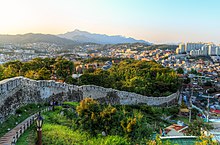
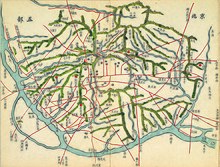
Seoul was planned capital of the Joseon. Yi Seong-gye, who was the founding father of the Joseon, enthroned himself to the King Taejo at the capital of old Goryeo in 1392. He changed the name of his Kingdom from Goryeo to Joseon in 1393, and started to looking for the place where Joseon's new capital will be established. Through some sharp debates inside government, King Taejo chose Hanyang (Sindo) instead of Muak in September 1394. Hanyang, as the new capital of the Joseon, was planned as geographic embodiment of Korean Confucianism and its construction started in October 1394. Some early stages of its construction, such as major palaces including the Gyeongbokgung, was finished in 1395. Also the Fortress Wall surrounding the Hanyang city was partially finished around 1396.[37]: 96–111
The city of Hanyang was governed by Hanseongbu (한성부), an agency of the national government dedicated to affairs on administration of capital city. Hanseongbu divided the Hanyang city into two major category; Areas inside the Fortress Wall, and areas 10 Ri (Korean mile) around the Fortress Wall. Former areas were typically named as Seong-jung (성중; 城中) or Doseong-an (도성 안; lit. Inside the fortress) and latters were named as Seongjeosimni (Korean: 성저십리; Hanja: 城底十里; lit. 10 Ris around the fortress). The Doseong-an area later gained informal but popular name Sadaemun-an (사대문 안), which literally means 'areas inside of the Four Great Gates', and became the one and only downtown (city center) of Hanyang city.[38]: 90–100
In the late 19th century, after hundreds of years of isolation, Seoul opened its gates to foreigners and began to modernize. Seoul became the first city in East Asia to introduce electricity in the royal palace, built by the Edison Illuminating Company[39] and a decade later Seoul also implemented electrical street lights.[40]
Korean Empire

After Gojong's proclamation of Korea as the Korean Empire in 1897, Seoul was temporarily called Hwangseong (황성; 皇城), literally "the imperial city." Much of modern development around this era was propelled by trade with foreign countries like France and the United States. For example, the Seoul Electric Company, Seoul Electric Trolley Company, and Seoul Fresh Spring Water Company were all joint Korean–U.S. owned enterprises.[41]
In 1904, an American by the name of Angus Hamilton visited the city and said, "The streets of Seoul are magnificent, spacious, clean, admirably made and well-drained. The narrow, dirty lanes have been widened, gutters have been covered, roadways broadened. Seoul is within measurable distance of becoming the highest, most interesting and cleanest city in the East."[42]
Japanese annexation of Korea

After the annexation treaty in 1910, Japan annexed Korea and renamed the city Gyeongseong ("Kyongsong" in Korean and "Keijō" in Japanese). The city saw significant transformation under Japanese colonial rule. Imperial Japan removed the city walls, paved roads, and built Western-style buildings.
Seoul was deprived of its special status as the capital city and downsized under imperial Japan, compared to the traditional notion among people of the Joseon dynasty that Seoul included the area of approximately 4 km (2.5 mi) radius surrounding the Fortress Wall (i.e., Outer old Seoul; 성저십리; 城底十里). On October 1, 1910, Imperial Japan demoted Seoul as no different than any other city within the Gyeonggi province. After Imperial Japan's redistricting, Seoul only included the area inside the Fortress Wall and present-day Yongsan-gu. In the 1930s, as part of Imperial Japan's war efforts leading up to the Second Sino-Japanese War, Yeongdeungpo-gu was annexed into Seoul on April 1, 1936 to function as an industrial complex for steel and other metalworking factories.
The city was liberated by U.S. forces at the end of World War II.
Contemporary history

In 1945, following the liberation from Japanese colonial rule, the American military assumed control of Korea, including its capital city, then referred to as Kyeongseongbu in line with Japanese nomenclature. The U.S. military government published the Charter of the City of Seoul in the official gazette the following year. The charter declared Seoul as the name of the city and established it as a municipal corporation. Seoul's status as a municipal corporation mirrored the independent cities in the United States that do not belong to any county, and Seoul was established as an independent administrative unit, separate from the existing provinces.[43] The Korean version of the Charter translated "municipal corporation" as "special free city" (특별자유시), which later became special city (or special metropolitan city; 특별시) in the Local Autonomy Act of 1949. Seoul has retained its status as the only special city in South Korea (i.e., 서울특별시).[citation needed]
The City of Seoul is hereby constituted a municipal corporation to be known as SEOUL. The boundaries of the municipal corporation are the present limits of the City of Seoul consisting of the following eight districts: Chong Koo, Chong No Koo, Sur Tai Moon Koo, Tong Tai Moon Koo, Sung Tong Koo, Ma Po Koo, Yong San Koo, and Yang Doung Po Koo, and as such may be extended as provided by law.
— U.S. Army Military Government in Korea, Charter of the City of Seoul
Seoul under the U.S. military government between 1945 and 1948 was much smaller than it is today. It only covered the Fortress Wall, marked by the Eight Gates, and the districts incorporated during Japanese rule to prosecute imperial Japan's war efforts.[44]
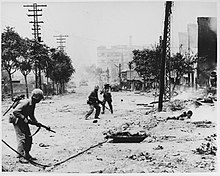
During the Korean War, Seoul changed hands between the Soviet/Chinese-backed North Korean forces and the American-backed South Korean forces four times: falling to the North Koreans in the June 1950 First Battle of Seoul, recaptured by UN forces in the September 1950 Second Battle of Seoul, falling to a combined Chinese/North Korean force in the January 1951 Third Battle of Seoul, and finally being recaptured once more by UN forces in Operation Ripper during the spring of 1951.[45][46] The extensive fighting left the city heavily damaged after the war. The capital was temporarily relocated to Busan.[19] One estimate of the extensive damage states that after the war, at least 191,000 buildings, 55,000 houses, and 1,000 factories lay in ruins. In addition, a flood of refugees had entered Seoul during the war, swelling the population of the city and its metropolitan area to an estimated 1.5 million by 1955.[47]
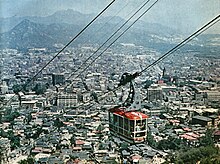
Following the war, Seoul began to focus on reconstruction and modernization. As South Korea's economy started to grow rapidly from the 1960s, urbanization also accelerated and workers began to move to Seoul and other larger cities.[47] In 1963, Seoul went through two major expansions that established the shape and size of the present-day Seoul—barring minor adjustments to the borders later in 1973 and 2000. In August 1963, Seoul annexed parts of Yangju-gun, Gwangju-gun, Siheung-gun, Gimpo-gun, and Bucheon-gun, expanding the northeastern borders of Seoul. In September, Seoul again annexed present-day Gangnam.[48][49] The two consecutive expansions more than doubled the size of Seoul from approximately 268 km2 (103 sq mi) to 613 km2 (237 sq mi).[50]
After annexation, Gangnam's development was spurred by key infrastructure projects: the construction of the Hannam Bridge (1966–1969) and Gyeongbu Expressway (1968–1970). As Seoul's population kept growing, Park's regime focused its development plans on Gangnam. The main hurdle for Gangnam's development was floods because the area is low-lying and prone to flooding. Then Seoul mayor Kim Hyun-ok ordered construction of an expressway that doubled as embankment, which became the present-day Gangbyeon Expressway. The construction started in March 1967 and completed in September of the same year. Similar projects transformed previously flood-prone areas into usable land for development. Such areas include the current Ichon-dong, the Banpo apartment complex, Apgujeong-dong and Jamsil-dong.
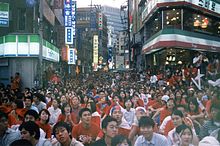
Until 1972, Seoul was claimed by North Korea as its de jure capital, being specified as such in Article 103 of the 1948 North Korean constitution.[51]
Seoul was the host city of the 1986 Asian Games and 1988 Summer Olympics as well as one of the venues of the 2002 FIFA World Cup.
South Korea's 2019 population was estimated at 51.71 million, and according to the 2018 Population and Housing Census, 49.8% of the population resided in the Seoul metropolitan area. This was up by 0.7% from 49.1% in 2010, showing a distinct trend toward the concentration of the population in the capital.[52] Seoul has become the economic, political and cultural hub of the country,[19] with several Fortune Global 500 companies, including Samsung, SK Holdings, Hyundai, POSCO and LG Group headquartered there.[53]
Geography
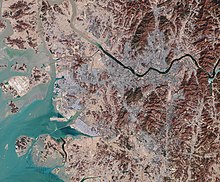
Seoul is in the northwest of South Korea. Seoul proper comprises 605.25 km2 (233.69 sq mi),[3] with a radius of approximately 15 km (9 mi), roughly bisected into northern and southern halves by the Han River. The river is no longer actively used for navigation, because its estuary is located at the borders of the two Koreas, with civilian entry barred. There are four main mountains in central Seoul: Bugaksan, Inwangsan, Naksan and Namsan. The Seoul Fortress Wall, which historically bounded the city, goes over these mountains. The city is bordered by eight mountains, as well as the more level lands of the Han River plain and western areas.
Parks
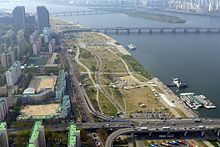
Seoul has a large quantity of parks. One of the most famous parks is Namsan Park, which offers recreational hiking and views of the downtown Seoul skyline, especially via its N Seoul Tower. Seoul Olympic Park, located in Songpa District and built to host the 1988 Summer Olympics, is the largest park. The areas near the stream Tancheon are popular for exercise. Cheonggyecheon also has spaces for recreation. In 2017 the Seoullo 7017 Skypark opened, spanning diagonally overtop Seoul Station.
There are also many parks along the Han River, such as Ichon Hangang Park, Yeouido Hangang Park, Mangwon Hangang Park, Nanji Hangang Park, Banpo Hangang Park, Ttukseom Hangang Park and Jamsil Hangang Park. The Seoul National Capital Area also contains a green belt aimed at preventing the city from sprawling out into neighboring Gyeonggi Province. These areas are frequently sought after by people looking to escape from urban life on weekends and during vacations.
Air quality

Air pollution is a major issue in Seoul.[54][55][56][57] According to the 2016 World Health Organization Global Urban Ambient Air Pollution Database,[58] the annual average PM2.5 concentration in 2014 was 24 micrograms per cubic meter (1.0×10−5 gr/cu ft), which is 2.4 times higher than that recommended by the WHO Air Quality Guidelines[59] for the annual mean PM2.5. The Seoul Metropolitan Government monitors and publicly shares real-time air quality data.[60]
Since the early 1960s, the Ministry of Environment has implemented a range of policies and air pollutant standards to improve and manage air quality for its people.[61] The "Special Act on the Improvement of Air Quality in the Seoul Metropolitan Area" was passed in December 2003. Its 1st Seoul Metropolitan Air Quality Improvement Plan (2005–2014) focused on improving the concentrations of PM10 and nitrogen dioxide by reducing emissions.[62] As a result, the annual average PM10 concentrations decreased from 70.0 μg/m3 in 2001 to 44.4 μg/m3 in 2011[63] and 46 μg/m3 in 2014.[58] As of 2014, the annual average PM10 concentration was still at least twice than that recommended by the WHO Air Quality Guidelines.[59] The 2nd Seoul Metropolitan Air Quality Improvement Plan (2015–2024) added PM2.5 and ozone to its list of managed pollutants.[64]
Asian dust, emissions from Seoul and in general from the rest of South Korea, as well as emissions from China, all contribute to Seoul's air quality.[55][65] Besides air quality, greenhouse gas emissions represent hot issues in South Korea since the country is among top-10 strongest emitters in the world. Seoul is the strongest hotspot of greenhouse gas emissions in the country and according to satellite data, the persistent carbon dioxide anomaly over the city is one of the strongest in the world.[66]
Climate
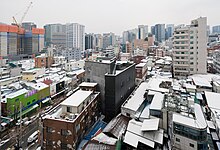
Seoul has a humid continental (Köppen: Dwa) or humid subtropical climate (Cwa, by −3 °C or 26.6 °F isotherm), influenced by the monsoons; there is great variation in temperature and precipitation throughout the year.[67][68] The suburbs of Seoul are generally cooler than the center of Seoul because of the urban heat island effect.[69] Summers are hot and humid, with the East Asian monsoon taking place from June until September. August, the hottest month, has average high and low temperatures of 30.0 and 22.9 °C (86 and 73 °F) with higher temperatures possible. Heat index values can surpass 40 °C (104.0 °F) at the height of summer. Winters are usually cold to freezing with average January high and low temperatures of 2.1 and −5.5 °C (35.8 and 22.1 °F), and are generally much drier than summers, with an average of 24.9 days of snow annually. Sometimes, temperatures drop dramatically to below −10 °C (14 °F), and on some occasions as low as −15 °C (5 °F) in the mid winter period of January and February. Temperatures below −20 °C (−4 °F) have been recorded.
| Climate data for Seoul (1991–2020 normals, extremes 1907–present) | |||||||||||||
|---|---|---|---|---|---|---|---|---|---|---|---|---|---|
| Month | Jan | Feb | Mar | Apr | May | Jun | Jul | Aug | Sep | Oct | Nov | Dec | Year |
| Record high °C (°F) | 14.4 (57.9) |
18.7 (65.7) |
25.1 (77.2) |
29.8 (85.6) |
34.4 (93.9) |
37.2 (99.0) |
38.4 (101.1) |
39.6 (103.3) |
35.1 (95.2) |
30.1 (86.2) |
25.9 (78.6) |
17.7 (63.9) |
39.6 (103.3) |
| Mean daily maximum °C (°F) | 2.1 (35.8) |
5.1 (41.2) |
11.0 (51.8) |
17.9 (64.2) |
23.6 (74.5) |
27.6 (81.7) |
29.0 (84.2) |
30.0 (86.0) |
26.2 (79.2) |
20.2 (68.4) |
11.9 (53.4) |
4.2 (39.6) |
17.4 (63.3) |
| Daily mean °C (°F) | −2.0 (28.4) |
0.7 (33.3) |
6.1 (43.0) |
12.6 (54.7) |
18.2 (64.8) |
22.7 (72.9) |
25.3 (77.5) |
26.1 (79.0) |
21.7 (71.1) |
15.0 (59.0) |
7.5 (45.5) |
0.2 (32.4) |
12.8 (55.0) |
| Mean daily minimum °C (°F) | −5.5 (22.1) |
−3.2 (26.2) |
1.9 (35.4) |
8.0 (46.4) |
13.5 (56.3) |
18.7 (65.7) |
22.3 (72.1) |
22.9 (73.2) |
17.7 (63.9) |
10.6 (51.1) |
3.5 (38.3) |
−3.4 (25.9) |
8.9 (48.0) |
| Record low °C (°F) | −22.5 (−8.5) |
−19.6 (−3.3) |
−14.1 (6.6) |
−4.3 (24.3) |
2.4 (36.3) |
8.8 (47.8) |
12.9 (55.2) |
13.5 (56.3) |
3.2 (37.8) |
−5.1 (22.8) |
−11.9 (10.6) |
−23.1 (−9.6) |
−23.1 (−9.6) |
| Average precipitation mm (inches) | 16.8 (0.66) |
28.2 (1.11) |
36.9 (1.45) |
72.9 (2.87) |
103.6 (4.08) |
129.5 (5.10) |
414.4 (16.31) |
348.2 (13.71) |
141.5 (5.57) |
52.2 (2.06) |
51.1 (2.01) |
22.6 (0.89) |
1,417.9 (55.82) |
| Average precipitation days (≥ 0.1 mm) | 6.1 | 5.8 | 7.0 | 8.4 | 8.6 | 9.9 | 16.3 | 14.7 | 9.1 | 6.1 | 8.8 | 7.8 | 108.6 |
| Average snowy days | 7.1 | 5.1 | 2.8 | 0.2 | 0.0 | 0.0 | 0.0 | 0.0 | 0.0 | 0.0 | 2.3 | 6.4 | 23.9 |
| Average relative humidity (%) | 56.2 | 54.6 | 54.6 | 54.8 | 59.7 | 65.7 | 76.2 | 73.5 | 66.4 | 61.8 | 60.4 | 57.8 | 61.8 |
| Mean monthly sunshine hours | 169.6 | 170.8 | 198.2 | 206.3 | 223.0 | 189.1 | 123.6 | 156.1 | 179.7 | 206.5 | 157.3 | 162.9 | 2,143.1 |
| Percent possible sunshine
Zdroj:https://en.wikipedia.org?pojem=Hansong Text je dostupný za podmienok Creative Commons Attribution/Share-Alike License 3.0 Unported; prípadne za ďalších podmienok. Podrobnejšie informácie nájdete na stránke Podmienky použitia.
Analytika
Antropológia Aplikované vedy Bibliometria Dejiny vedy Encyklopédie Filozofia vedy Forenzné vedy Humanitné vedy Knižničná veda Kryogenika Kryptológia Kulturológia Literárna veda Medzidisciplinárne oblasti Metódy kvantitatívnej analýzy Metavedy Metodika Text je dostupný za podmienok Creative
Commons Attribution/Share-Alike License 3.0 Unported; prípadne za ďalších
podmienok. www.astronomia.sk | www.biologia.sk | www.botanika.sk | www.dejiny.sk | www.economy.sk | www.elektrotechnika.sk | www.estetika.sk | www.farmakologia.sk | www.filozofia.sk | Fyzika | www.futurologia.sk | www.genetika.sk | www.chemia.sk | www.lingvistika.sk | www.politologia.sk | www.psychologia.sk | www.sexuologia.sk | www.sociologia.sk | www.veda.sk I www.zoologia.sk | |||||||||||||








